
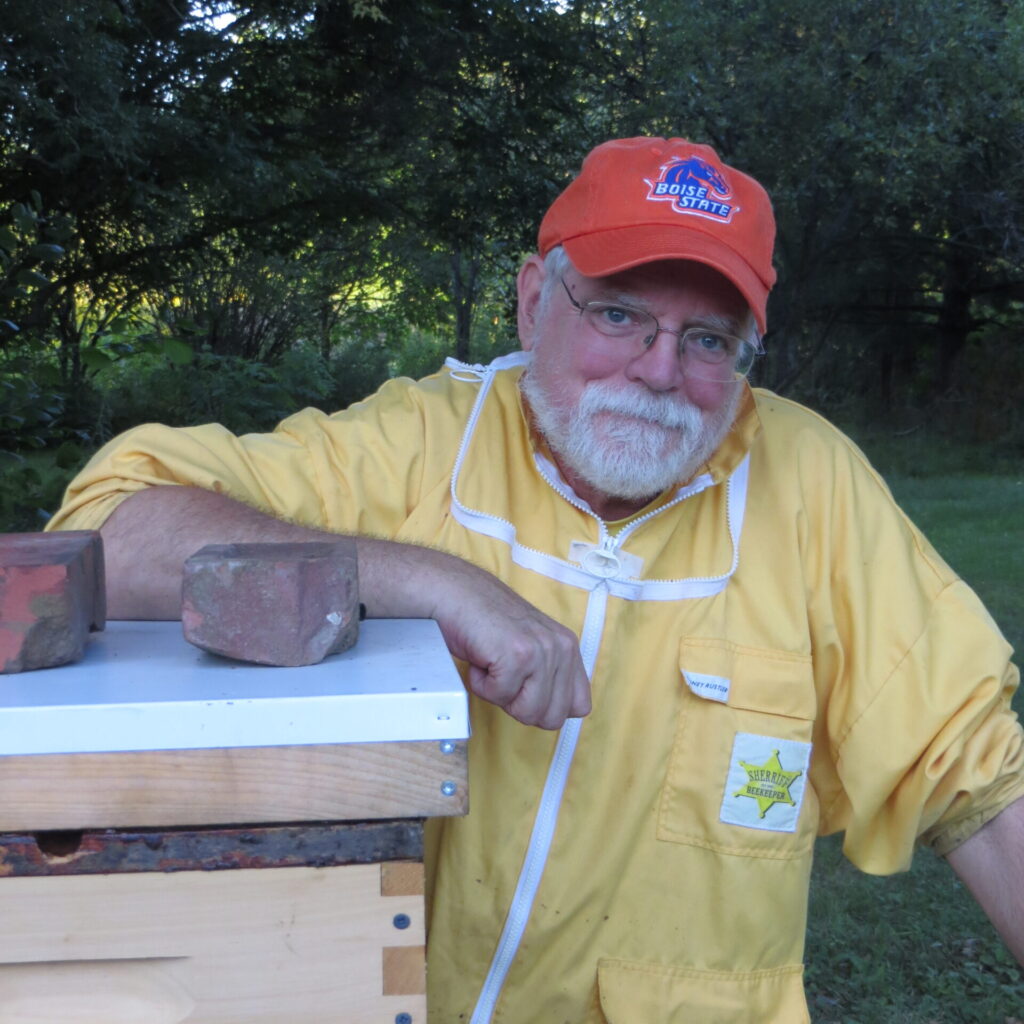
Introduction.
A big warm welcome to Kim Flottum from Medina, Ohio. Kim was the editor of America’s prestigious magazine, BeeCulture, for over 30 years till his recent retirement. I met him at The Eastern Apiculture Society Meeting in Delaware in 2017, and he has published a few of my articles in the past. Kim is a highly respected beekeeper and educator and you can find his National Honey Show presentations recorded below.
https://www.honeyshow.co.uk/lecture-videos.php
Kim is the author of many magazine articles and several books including In Business with Bees, and Honey Bee Pests, Predators and Diseases which was written with Roger Morse. Anyone considering expanding their beekeeping hobby to make an income should read In Business with Bees which is full of useful advice and tips which are relevant wherever you live (see link at the end of blog).
Podcasting in the Beekeeping World: Growing Planet Media.
Just over three years ago, Jeff Ott, a friend who used to live in my hometown of Medina, Ohio came back for a visit. We had both belonged to the local beekeeping club before he moved away and he had started the first newsletter produced for members. He wrote for our magazine for a bit, then moved to Colorado, still writing for us, then moved to the State of Washington, where he still resides.
When he came to visit we talked of old times, and then he asked if I’d ever considered being part of a Podcast. I admit, I had to ask what a podcast was. Jeff is an IT person in his day job, and a musician, too, so the technology of doing this was familiar to him. I had to learn the ropes in a hurry, but with his help we were soon on our way.
Beekeeping Today Podcast is supported by the Company we formed called Growing Planet Media and is a weekly experience, where Jeff and I interview people we find interesting in the beekeeping world. It’s not a how-to program, but mostly talks with scientists, researchers, authors, politicians and others who affect what happens in the beekeeping industry. We also talk to commercial and sideline, and even hobby beekeepers on what they are doing, what is affecting their worlds and what can be done to fix the problems, and make the good things better.
With 100+ shows, and over 90,000 downloads now under our belt, here’s a short list of who you can find there…
Minnesota Bee Squad, The Bee Corp (inspecting bee hive with infrared) 4 US Regional beekeepers, Marla Spivak and propolis, QSI America and honey adulteration, Bananas for bees, Manuka honey, honey tasting, almond contracts, Dewey Caron, and lots more. And soon, we hope, Ann Chilcott.
Growing Planet Media also supports the podcast 2MillionBlossoms, with Kirsten Traynor, who focuses on all pollinators, and Honey Bee Obscura, where Jim Tew (Bee Culture writer and Ohio State Extension Bee Specialist) and myself explore a honey bee related topic once a week – queens, outyards, stings, comb honey and an assortment of other honey bee topics. There are no guests, and the programs are short and to the point.
https://www.beekeepingtodaypodcast.com/
https://www.honeybeeobscura.com/
https://www.2millionblossoms.com/
Kim Flottum
Thank You, Kim.
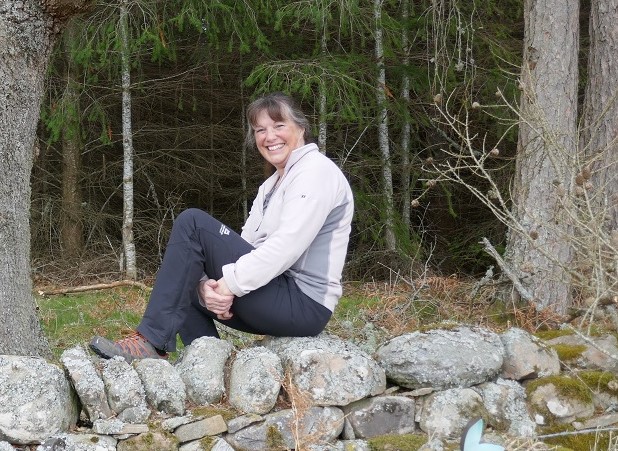
Bee Biology.
A big warm welcome back to Jane who has taken time out from studying for an upcoming exam to share some thoughts and her work with you.
Jane lives on the edge of a grouse moor in rural Nairnshire. I’ve lost track of how long Jane has been beekeeping, but she’s successful and continues to be curious about what goes inside the hives and spends a lot of time observing and learning from outside the hive. Jane likes honey but it is not all about that for her.
Learning
I was that annoying person at school/university/work who asked the question “why” – all the time- I still do it. My first season of having bees, I sat beside the hives for ages, watching, taking photographs and pondering, a constant internal stream of questions…. every bee appears to wash her face and hands on the landing board before flying off to forage. Why? Why do bees rub their legs together when they fly? Why do some bees have pollen on the back of their thoraxes after returning to the hive? And so on…… the list is endless.
I don’t know why, but I love the feeling of the WOW factor when the penny drops and I learn something new. This learning feeling is a sigh, an intake and slow outbreath- an “Aaaaha” sound. This feeling is an excitement or that butterfly fluttering around inside your tummy, and I have to tell someone – resulting in the “Did you know !!…” conversation. Since I have been keeping bees it has become irritating for some.… I needed to channel my mind in a focused way.
Strange to say but Lockdown presented an opportunity. The SBA (Scottish Beekeepers Association) online exam system, giving the opportunity of doing an exam without driving, worrying where the centre is, sitting the exam in a freezing village hall, shivering after 5 minutes and taking hours after to warm up. You can sit in your own kitchen with the fire on and type as fast as possible for an hour plus. That said, I haven’t done the exam yet. The outcome may be different! So, I decided (encouraged by Ann) to start studying for Module 5 (Honeybee biology).
So much detail in the syllabus! I needed to address my usual learning style, a global approach, a dip in-dip-out-let’s- get -distracted routine, flitting from one subject to another, finding commonalities and links which, although interesting (to me!) weren’t really relevant; at times others cannot see the links and taking ages to explain the links detracts from the satisfaction of the lightbulb moment. Surprisingly, I’ve found myself being methodical and working through the syllabus slowly, even carefully.
Time in lockdown has meant that I can sit and draw anatomical parts. I have spent a long time designing mind maps, making notes and teaching the dog. But, the most rewarding item, recently purchased, is a second hand Brunel dissecting microscope and a set of dissecting tools. Looking down the lens at bee parts is incredible. The routine is the same every time. I read (Stell, Winston and Davis) on the relevant topic. I make (unseen) notes from memory. I go to the freezer and extract a bee and dissect away to my heart’s content. Look down, draw what I see, and look up the detail.
Looking down a microscope brings learning bee anatomy alive. The detail is breathtaking. All that bee fur that looks as if Ms Apis Mellifera Mellifera has applied some nice hair gel! All that shiny leg fur – her diet must be good! I give myself headaches and realise that when I look at bee parts I don’t blink. My eyes are constantly dry. I can’t tear myself away from it. Looking down that tube has become my obsession, made even worse by the fact that my phone can take pretty good pictures of the bee parts that I gaze at …. ad nauseam.
Legs!
The original “why” questions posed at the start of this wee note are answered! Endless hours of fascinated bee-watching beside the landing board, sat on my home made log-seat wondering why bees seem to “wash their faces and hands”

It is because the first pair of legs are close to the bee’s neck, are able to move freely over head and upper thorax and are in possession of a tiny notch and a tiny lever (fibula) on the opposite side of the joint. The antennae of the bee are super- sensitive acting as the bee’s nose which unsurprisingly is very important when sniffing out nectar. They need to be clean and free of dust and dirt. The bee is able to insert each antenna into the notch, close the lever over the top and draw the antenna through the now constricted, space. Voilà, she is dusted down and ready to fly.
Noticing bees rubbing their back legs together when in flight is also curious. The assumption (mine anyway) was that the bee flits from flower to flower, pollen automatically migrating onto the pollen baskets (corbiculae). In fact the bee is so unbelievably busy when in flight. The hind leg is beautiful. Under the microscope the colour is iridescent- chestnut, with auburn hairs. The legs are jointed and mobile, allowing for a variety of functions – the forelegs dust pollen from the head and upper thorax, the middle legs then brush the pollen load from the front legs, passing the load through to the hind legs. The inner surface of the hind leg is covered with a line of 9 brushes, specifically designed to attract pollen. These brushes rub together in flight, pressing the inner surfaces of the basitarsi together, towards a stiffer comb, called the rastellum, located at the joint between the tibia and basitarsus. These bristles face downwards, making it easier to comb and press the pollen, moistened by a small amount of nectar, into the shopping baskets corbiculae when in flight from flower to flower.
But wait:
How does the bee transfer the propolis and pollen back towards the corbiculae?
And why is there a spine on the middle leg between the tibia and basitarsus?
According to Davis (2004) and Stell (2012) no one knows- yet, but Professor Jamie Ellis (2021) says that the bees may use this spine to prise pollen and propolis thus helping move it to back legs!
Thank You, Jane.
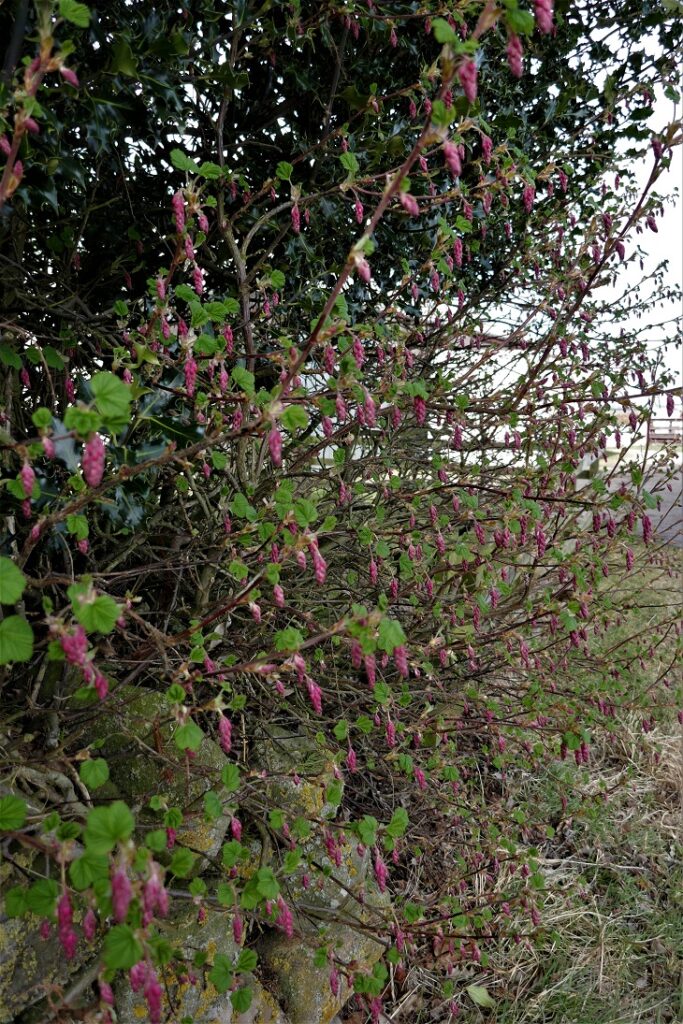
Nature Notes.
We should rewrite part of the beekeeping text books that tell us we can do our first hive inspections of the year in the UK when our “bee barometer” the flowering currant blooms. Well, not around here this year anyway. It was a very cold day when I took this picture on a long walk to check out the arrival of spring along the roadside verges and in the fields. It is warming up but still far too early to disturb the bees. However, the willow tree along the road in Piperhill is in full flower and masses of yellow pollen is coming into all the hives this week.
There are not many flowers to be seen on my walk but the birds that herald spring have arrived. I hear my first skylark of the season high above me in the blue sky. Lapwings/plovers/peewits with their familiar shrill sqeaking call and flappy flight travel close to the ground searching out nest sites. Oyster catchers returning from the shoreline, also nest site hunting, call out their familiar notes taking me back to childhood springs on the farm in Argyll. I feel as if the show is being put on just for me when I come across two mad March hares cavorting in a stubble field. I think I’ve hit the jackpot then but I see the first frog spawn of spring in a ditch, masses of it too. I’m wrong though about the jackpot for I hit it when I come back into our garden. I see a red squirrel dangling off the bird feeder. Actually, he is clinging on tight and totally engaged with prising out peanut fragments from the wire mesh holder. I’m more than excited because this is the first time in 28 years of living here that red squirrels have visited to feed. They are meant to use the squirrel feeder but I guess they will learn in time that it is much more rewarding to open the lid and help themselves to whole peanuts.
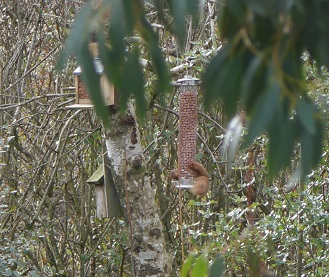
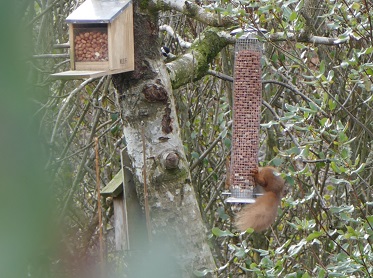

The flowering currant in our Devon garden is just coming into flower and I am awaiting an influx of bees!
Great!
That was fun to read, Jane. Thank you. I guess we will continue to ask ‘Why?’ about the tibial spine for some time yet. Apparently it is older bees that collect propolis as the removal is done by house bees chewing it off the forager’s corbiculae; this is a destructive process and it is shortsighted to damage a young forager.The function of the tibial spine on each middle leg is still a mystery, especially as the queen and the drone have them too and those castes don’t forage for pollen and propolis, (they are found on many other insects – even aquatic ones too). Maybe one day someone will find out, now that filming bees has become much easier. When I talked to Alan Riach about it at St Andrews, after mounting all the legs on a slide, and he said the tibial spine could be a redundant part of the insect anatomy.
Jane may reply herself, Margaret Anne, but it was a good read and glad that you enjoyed it. There are still so many things that we don’t yet know.Rusty Burlew says that the worker spine is used to move wax flakes and pollen. Given that drones have to grip onto queens during mating, I wonder if their middle leg spines help them, and if queens use theirs when fighting other queens. They certainly hold onto each other in these fights.
Yes it will depend on what is seen on film. Joseph Coelho concluded in a paper (https://www.academia.edu/836032/The_flight_characteristics_of_drones_in_relation_to_mating) that the Drone was very large so that he could carry the queen during mating, but a film eventually showed the queen doing all the flying while the drone just concentrated on copulating while clinging on to her (as you say he could be using the tibial spines). Joseph was very nice about it.